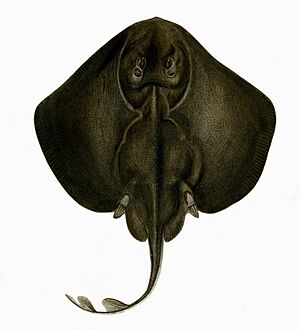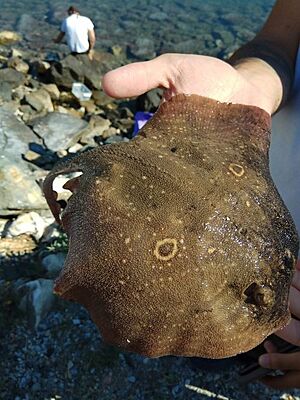Rough ray facts for kids
Quick facts for kids Rough ray |
|
|---|---|
 |
|
| Rough ray ventral side | |
| Conservation status | |
| Scientific classification | |
| Genus: |
Raja
|
| Species: |
radula
|
The rough ray (Raja radula) is a type of ray that lives in the Mediterranean Sea. It belongs to the Rajidae family, which are often called skates or rays. A scientist named Delaroche first described this species in 1809.
Contents
What Does the Rough Ray Look Like?
The rough ray gets its name from the small, spiky bumps called spinules that cover its top side.
- Young rays and males have these rough spinules mostly on their snout (nose area) and the bottom half of their tail.
- Female rough rays have spinules in these places too, but also around their mouth, along their middle body, and all over their tail.
These spinules are different from the larger thorns found near their eyes and along their back. There are also two thorns between their two dorsal fins (fins on their back).
The rough ray's body is mostly round, with a short, curved snout. Its front edges are curved, and its "wings" (pectoral fins) are pointed at the ends. Most rough rays grow to be about 70 centimeters (about 27 inches) long.
Their upper body is usually light brown or grey. It often has darker spots and lines. They have two special "eye-spots" on their back. These spots have yellow rings inside a thicker, darker outer ring with light dots. They are located on each side of the spine, where the body is widest. The underside of the ray is white, with darker edges and some dark spots on the tail.
Where Do Rough Rays Live?
The rough ray is a bottom-dwelling (benthic) species. This means it lives on or near the seabed. It is found only in the Mediterranean Sea. Some old reports of rough rays in the Atlantic Ocean might have been other similar species.
These rays prefer coastal areas. They live in waters between 2 and 300 meters (about 6 to 980 feet) deep. They like sandy or muddy bottoms on the continental shelf.
What Do Rough Rays Eat?
Rough rays seem to have short feeding times and digest their food quickly. They mostly eat animals that live on the seafloor. These include:
- Crustaceans (like crabs and shrimp)
- Fish (called teleosts)
- Mollusks (like snails and clams)
Crustaceans are their favorite food, followed by fish. Interestingly, what a rough ray eats can change as it grows bigger.
- Smaller and medium-sized rays eat mostly crustaceans.
- Larger rays tend to specialize in eating fish.
This change in diet shows that rough rays are flexible eaters. They can adapt their diet based on their energy needs as they grow. It also helps them avoid competing for food with younger rays. Young rough rays are active feeders during the day all year round. They also have a faster metabolism than adults.
The diet of rough rays can also differ depending on where they live. This is because the types and amounts of prey available vary from place to place. Rays are active hunters. However, sometimes they eat dead animals too, acting like scavengers. They are considered secondary consumers, meaning they eat other animals. But they are flexible enough to change their diet based on what's available. Their position in the food chain might even go up as they get older.
Rough Ray Life Cycle and Reproduction
Like many other rays, the rough ray reproduces by laying eggs. This is called oviparous reproduction.
- The eggs are laid inside a protective case, which is about 5.1 to 5.7 centimeters (about 2 inches) long.
- The baby rays hatch from these eggs after about 4 months.
Rough rays reproduce all year long. However, they lay the most eggs in late spring and early summer.
Males and females become ready to reproduce at different sizes and ages:
- Females are mature when their body (disc width) is about 34 cm (13 inches). They reach this around 5.89 years old.
- Males are mature when their body (disc width) is about 30 cm (12 inches). They reach this around 4.47 years old.
Females can live up to 12 years and grow to a maximum length of 80 cm (31 inches). Males can live up to 9 years and reach a maximum length of 65 cm (25 inches). A rough ray that is 70 cm long is estimated to be about 9 years old.
How Do Rough Rays Move?
Most rays swim by making wavy motions with their large pectoral fins (their "wings"). This creates thrust that pushes them through the water. However, the rough ray has a special way of moving: it uses its pelvic fins.
The rough ray's pelvic fin movement has two parts:
- Recovery phase: One pelvic fin lifts off the bottom and moves forward.
- Propulsion phase: The other fin pushes firmly against the bottom.
When the ray moves its pelvic fins one after the other, its body stays flat and parallel to the seafloor. The ray often pushes itself off the bottom with a quick, strong push from its pelvic fins. Then, it might use its pectoral fins to glide. Even if the left and right pelvic fins don't move at exactly the same time, their movements are usually considered a synchronized "punt" that pushes the ray along.
Protecting the Rough Ray
The Mediterranean Sea faces many problems that threaten its marine life. These include city growth and too much fishing. Like other rays and sharks, the rough ray is often caught by accident during fishing, even though it's not usually sold for food.
The rough ray is listed as an Endangered species by the IUCN Red List. The biggest threat to this ray is being caught as "by-catch." This happens when fishing boats are trying to catch other animals like cuttlefish, lobsters, or certain types of fish. The rough ray gets caught in their nets (like trawl nets, gillnets, and trammel nets) or on their fishing lines.
Currently, there are no specific plans to protect the rough ray. It's not part of any education programs, market controls, or regular monitoring. It's also hard to know exactly how many rough rays are caught. This is because when they are caught, fishing records often just say "rays" instead of naming the specific species.
Despite this, one study showed that the rough ray was the sixth most commonly traded ray or shark in Palma de Mallorca. This species is not protected by international laws like CITES, even though its numbers are thought to have dropped by more than 50%. It's important to study this species more to create good conservation plans for this ray that lives only in the Mediterranean Sea.
See also
- List of threatened rays
- List of cartilaginous fish § Superorder Batoidea





